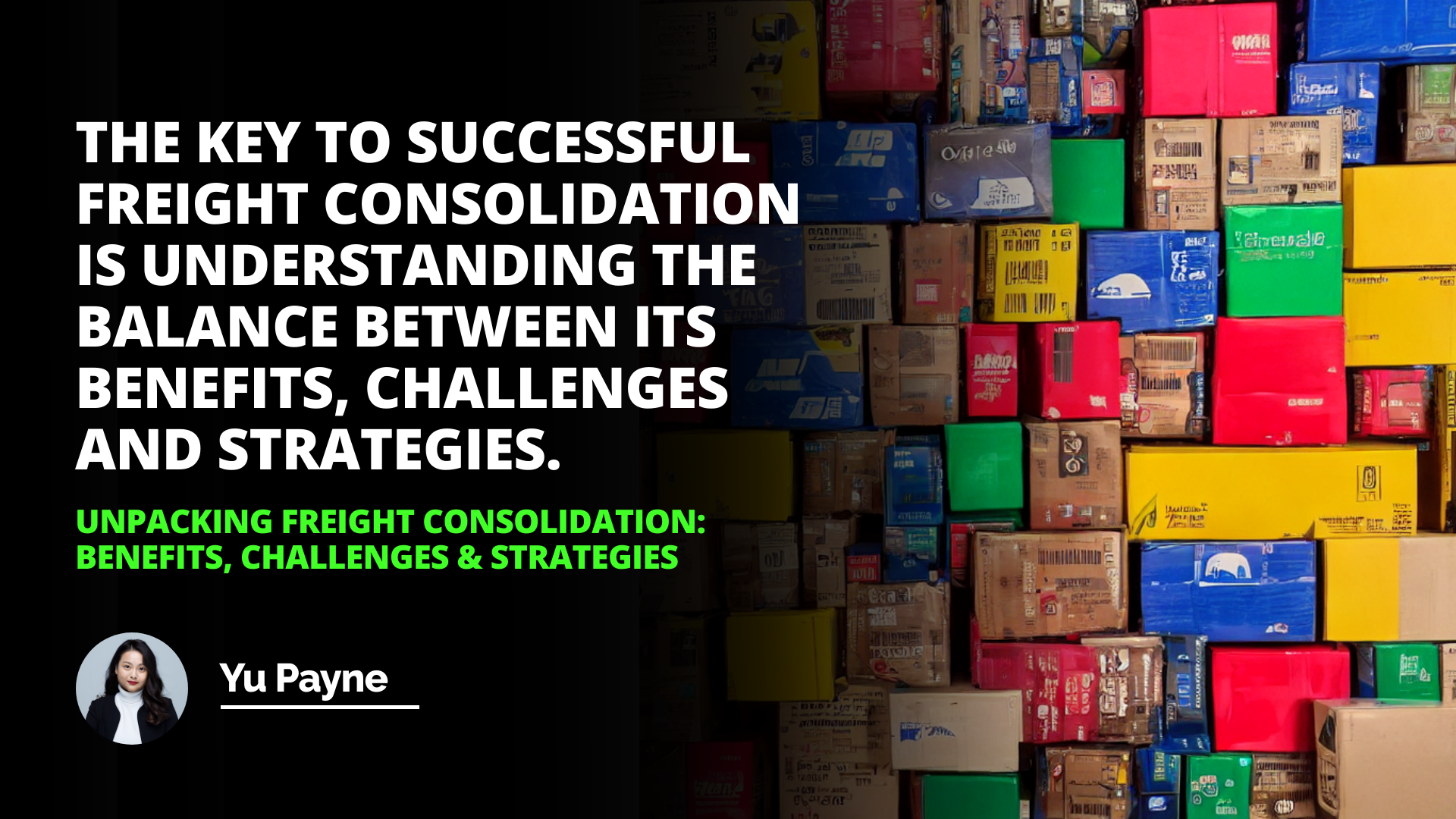
Introduction to Freight Consolidation
Benefits of Freight Consolidation
Challenges of Freight Consolidation
Strategies for Effective Freight Consolidation
Conclusion
Freight consolidation is an essential part of the supply chain process. It is a process used by logistics companies to combine multiple small shipments into one larger shipment. This process helps to reduce costs, increase efficiency, and improve service levels. Freight consolidation can be used for both international and domestic shipments. It is a cost-effective way for companies to move goods quickly and efficiently.
Benefits of Freight Consolidation
Freight consolidation has many benefits for businesses. First, it can help to reduce costs associated with shipping and handling. By combining multiple small shipments into one larger shipment, businesses can reduce shipping costs and save time.
Additionally, freight consolidation can provide better service levels. By consolidating shipments, companies can ensure that their products reach customers promptly.
Challenges of Freight Consolidation
Although freight consolidation can provide many benefits, it can also present some challenges. One of the significant challenges is that freight consolidation can be time-consuming. Companies must spend time and resources to identify which shipments should be consolidated and how they should be combined.
Additionally, there may be certain restrictions on what types of shipments can be combined.
For example, certain hazardous materials cannot be combined with other shipments. Companies must also take into account the cost of repackaging shipments when consolidating.
Strategies for Effective Freight Consolidation
In order to make the most of freight consolidation, businesses must have a clear strategy in place:
First, it is essential to determine which shipments should be consolidated.
Companies should identify which shipments are cost-effective to combine and which are not.
Businesses should consider any restrictions on what types of shipments can be combined.
Once a strategy has been developed, companies should ensure that they have an effective system to track shipments and monitor costs. Companies should also ensure their suppliers know the freight consolidation process and follow the necessary procedures. Additionally, companies should ensure that their freight consolidator is reliable and can provide timely and accurate shipments.
Conclusion
Freight consolidation is an essential part of the supply chain process. It can reduce costs, increase efficiency, and improve service levels. However, businesses need to have a clear strategy in place in order to make the most of freight consolidation.
For example, companies must determine which shipments should be consolidated and ensure an effective system to track shipments and monitor costs.
Additionally, companies should ensure that their freight consolidator is reliable and that they can provide timely and accurate shipments. By following these strategies, businesses can maximize the benefits of freight consolidation and ensure that their products reach their customers on time and cost-effectively.
The key to successful freight consolidation is understanding the balance between its benefits, challenges, and strategies.
Frequently Asked Questions
What are the benefits of freight consolidation?
Freight consolidation is a cost-saving strategy that has become increasingly popular in logistics. Freight consolidation is a process whereby multiple shipments or cargo, often from different sources and destinations, are combined into one shipment or cargo. This allows shippers to combine their resources and reduce their costs. In this article, we will discuss the various benefits of freight consolidation.
The most apparent benefit of freight consolidation is cost savings. By combining multiple shipments into one shipment, shippers can reduce their shipping costs by taking advantage of volume discounts and lower transportation rates due to increased efficiency in the transportation process. Furthermore, freight consolidators usually have access to various carriers and services, allowing them to find the most cost-effective solution for each shipment.
Another benefit of freight consolidation is improved delivery times. When shipments are consolidated, they are usually delivered faster than when shipped separately since only one shipment needs to be processed instead of multiple shipments that would require each shipment to be routed through separate carriers and networks. Furthermore, with fewer shipments being shipped at once, there is also less chance for delays due to traffic congestion or other events related to transportation networks, such as weather delays or road closures.
Freight consolidation also offers improved flexibility and reliability regarding delivery times. It allows shippers more control over their supply chain operations by allowing them to adjust routes quickly if needed due to changes in demand or unforeseen events such as road closures. Additionally, since all the cargo has been pre-screened prior to being consolidated into one shipment, it ensures that only compliant goods will be shipped, which helps improve reliability and compliance with regulations regarding hazardous materials or other restricted items that may not otherwise pass through customs without pre-screening prior processing them as part of a consolidated shipment.
Finally, one additional benefit of freight consolidation is better visibility throughout the entire supply chain process as all information related to each package can be tracked via an online dashboard which can provide shippers with real-time updates on its progress throughout its journey from pick-up point until delivery destination which allows for more accurate forecasting when planning future deliveries thus increasing overall supply chain efficiency while reducing costs associated with potential delays caused by mismanagement regarding orders tracking data availability in transit phases along its route delivery schedule expected final transit timeframes, etc.
In conclusion, freight consolidation provides numerous advantages in terms of reduced costs, improved delivery times, increased flexibility, better reliability, improved visibility throughout the entire supply chain process, etc., making it an attractive option for many businesses seeking ways to streamline their logistics operations while improving overall efficiency within their supply chains.
What challenges does freight consolidation present?
Freight consolidation is a process whereby multiple shipments are gathered into a single shipment and sent to a single destination. The idea is to improve the efficiency of shipping and reduce costs associated with shipping. However, several challenges must be addressed to make freight consolidation successful.
Risk management is one of the primary challenges associated with freight consolidation. Consolidating multiple shipments into one can increase the risk of damage or loss of goods due to increased handling. This can be addressed by instituting strict quality control measures and improved packaging. It is also essential to ensure that any damage or loss is covered through insurance or other forms of recourse.
Another challenge associated with freight consolidation is that of scheduling and coordination. Consolidating multiple shipments into one means that there are now more parties involved. This can lead to delays and other issues if proper coordination and scheduling are not in place. Therefore, it is essential to ensure that all parties involved are aware of the timeline and requirements for the shipment and that any issues that arise are addressed promptly.
Finally, the cost of freight consolidation must also be taken into account. While there can be cost savings associated with freight consolidation, it is essential to consider the added costs associated with handling and shipping the consolidated shipment. This includes additional labor and materials costs and any additional fees or taxes associated with the shipment. These costs must be weighed against the potential savings of freight consolidation in order to determine if it is cost-effective.
Overall, freight consolidation presents several challenges that must be carefully considered and addressed to succeed. This includes issues related to risk management, scheduling and coordination, and cost. However, by addressing these challenges, freight consolidation can be a viable option for businesses looking to reduce shipping costs.
What strategies can be used to ensure effective freight consolidation?
Freight consolidation is a critical factor in the success of supply chain management and is essential for achieving cost-effective transportation. To ensure effective freight consolidation, there are several strategies that businesses can employ to maximize efficiency and reduce costs.
First, businesses should use data analytics to identify opportunities for freight consolidation. By analyzing customer demand patterns and shipment data, companies can better understand what commodities should be shipped together to maximize economies of scale. Furthermore, companies should develop efficient routing plans that consider current market conditions and customer preferences to minimize the total number of shipments while meeting customer needs. This can help businesses reduce costs by avoiding over-shipping and under-shipping.
Second, businesses should leverage technology solutions such as transportation management systems (TMS) to streamline freight consolidation. TMS solutions enable companies to better manage their supply chain operations by providing real-time visibility into shipment movements, enabling more effective decision-making about when and how goods must be consolidated for transport. Additionally, TMS solutions provide predictive analytics capabilities that can help anticipate future demand patterns for optimization purposes.
Third, companies must establish strong relationships with carriers to ensure successful freight consolidation efforts. By leveraging long-term partnerships with reliable carriers familiar with their business operations, companies can secure competitive pricing while ensuring quality service delivery and on-time shipments. Furthermore, these relationships also allow shippers access to carrier networks that offer a more comprehensive range of services, such as intermodal transportation or less-than-truckload (LTL) shipping options that further increase efficiency levels and cost savings potentials through freight consolidation efforts.
Finally, businesses must remain agile in order to respond quickly when market conditions require adjustments in terms of routing plans or transportation methods used for consolidated shipments. By staying up-to-date on current trends within the logistics industry or changes within their organization’s infrastructure related to their supply chain operations, companies can proactively adjust strategies without disrupting business continuity objectives related to the timely delivery of goods or services promised by customers.
In conclusion, using data analytics solutions combined with leveraging technology tools such as TMS systems along with building solid relationships with carriers while remaining agile -- all contribute towards successful freight consolidation efforts that lead towards greater cost savings potentials through improved supply chain management practices overall.


